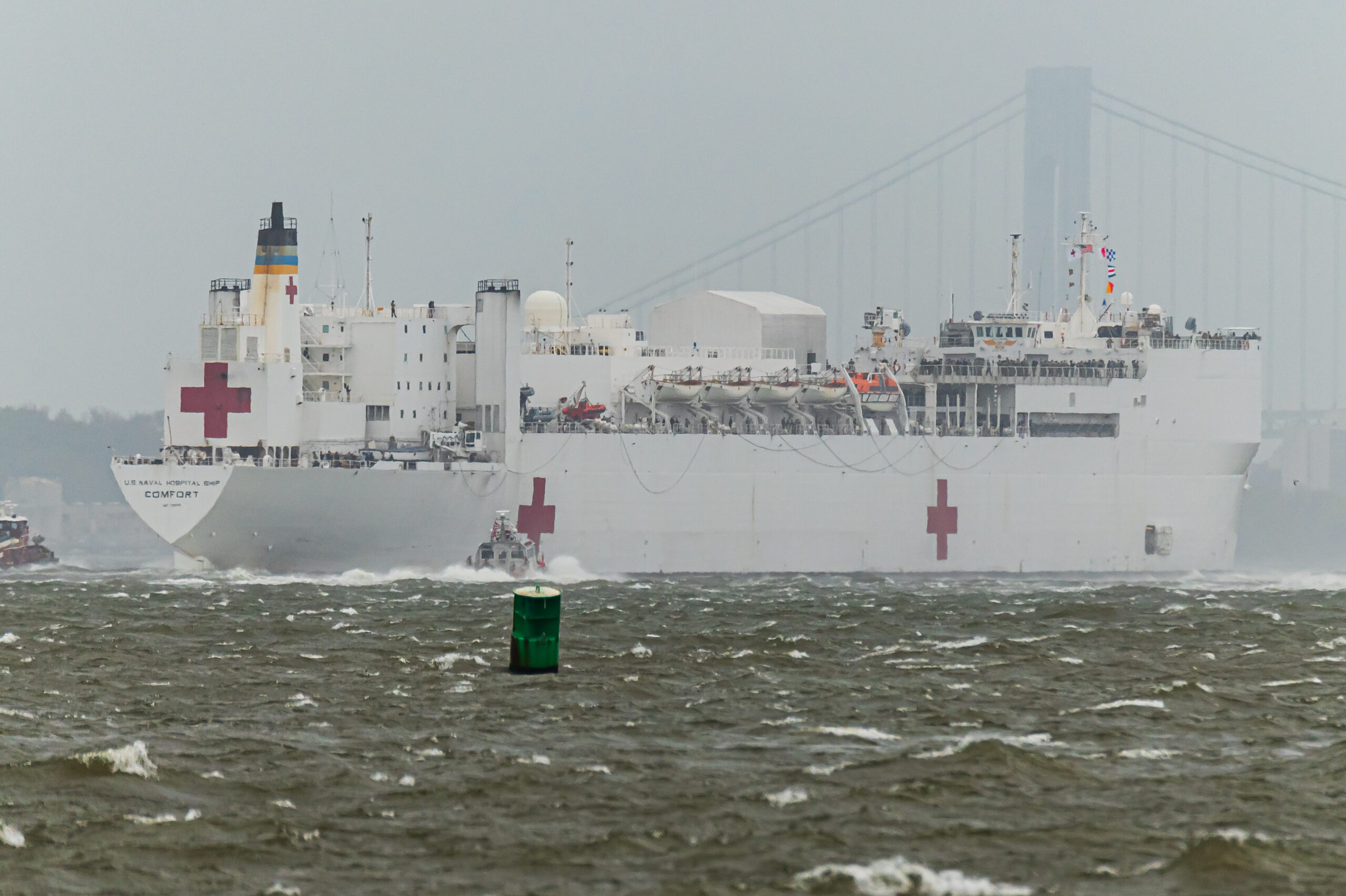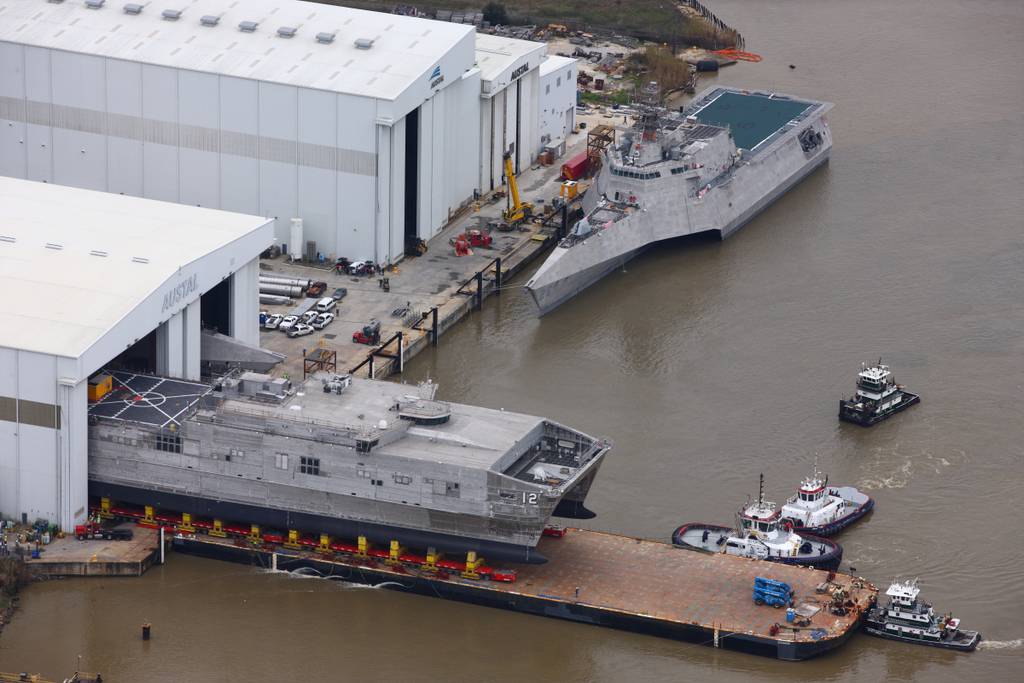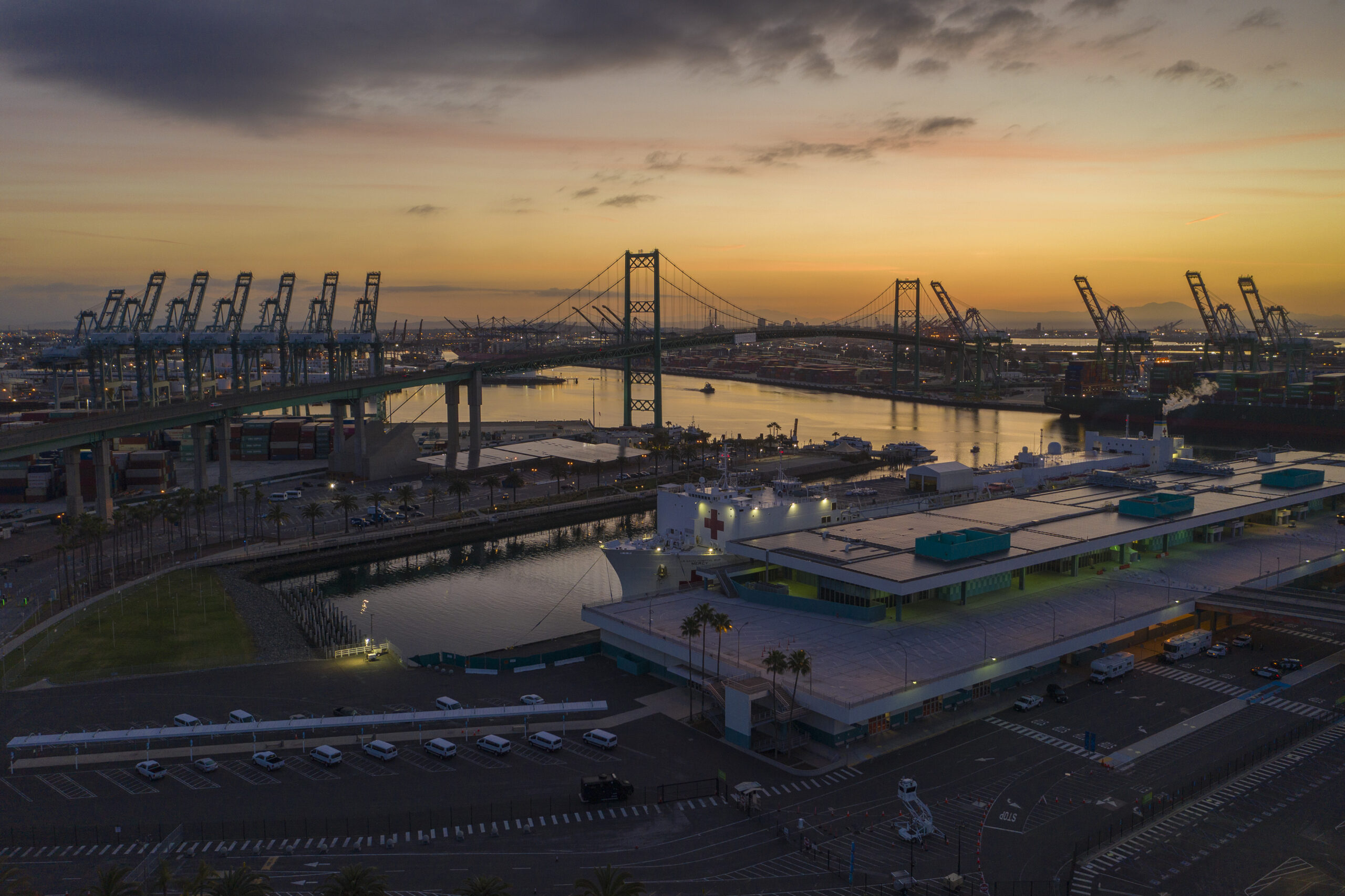By February of 2028, the Navy hopes to have a catamaran-hulled medical ship that its manufacturer says will have a top speed of at least 30 knots and a range of 5,500 nautical miles at 24 knots.
In its Fiscal Year 2023 justification book released last week, the Navy said an Expeditionary Medical Ship (EMS) variant of the Spearhead class Expeditionary Fast Transport will serve that role.
It would be smaller and faster than its two current hospital ships, the USNS Comfort and the USNS Mercy.

It’s not a one-to-one replacement for those ships – which the Navy tells The War Zone it will continue to sustain. But the sea service wants to be able to provide emergency medical care in locations that the Comfort and Mercy cannot reach because of their size and speed.
The two existing hospital ships are each nearly 900 feet long, with a displacement of nearly 70,000 tons and are capable of a top speed of 17 knots.
The Navy’s justification book has scant details on the specifications of the ship, currently referred to simply by its planned hull number EPF 17. However, from the description it does offer, as well as those of a medical variant of the EPF series provided by the shipbuilder, Austal, it seems likely that the resulting vessel will be about a third to almost half of the length of the Navy’s existing hospital ships and nearly twice as fast.
The last of a series of ships the Navy expects to procure from the Austal shipyard in Mobile, Alabama, the service said the Flight II ships in the class will be 338 feet long with a displacement of 2,400 metric tons.
Austal officials declined to comment on EPF 17 since it is not yet under contract. The company’s website highlights an Expeditionary Fast Transport-Medical Variant design that calls for a vessel to be 417 feet long and displace 3,100 metric tons, with a draft of just 13 feet.
Austal said its catamaran, which can reach 30 knots according to its website, “boasts several major advantages over the current hospital ships.”

That ship will be “faster to allow for quicker response time and its shallow draft hullform allows for direct access to shallow, austere ports,” Austal claims. “The flexible interior design is ideal for reconfiguring spaces for operating and recovery efforts and the flight deck is large enough to accommodate the V-22.”
Austal states its proposed medical variant will have room for 28 crew and 50 medical personnel: three operating rooms: six intensive care unit beds, 12 recovery beds, 20 intermediate care beds, 30 light care beds, and seating for 170. It will have one or two V-22 landing spots as well as platforms for transferring patients from watercraft, with the ability to launch and recover boast of up to 12.5 meters long.
EPF 17 will provide expanded Role 2 Enhanced Medical Transport capabilities, Jamie Koehler, a spokeswoman for the Naval Sea Systems Command, told The War Zone Thursday afternoon. “These expanded capabilities are currently being assessed.”
Having Role 2 Enhanced Medical Transport capabilities means a ship will be able to provide diagnostic, specialist and hospital care “essential to stabilize and prepare patients for strategic evacuation,” according to NATO’s Allied Joint Doctrine for Medical Support. It also includes, but is not limited to, surgery, x-ray, laboratory, blood bank, pharmacy, and sterilization services.
The Navy expects to award a contract for the vessel in September. Construction is expected to begin in December 2026, with the ship anticipated to enter service 14 months later. The expected cost for engineering and construction is about $330 million, Koehler said.
The Navy said it needs this new class of ship to ensure that future joint forces “will be responsive, deployable, agile, versatile, lethal, survivable, and sustainable.”

It is part of a plan to provide naval lift assets that can “provide for assured access, decrease predictability and dwell time, and have the capacity to quickly deliver troops and equipment together in a manner that provides for unit integrity.”
Compared to the Comfort and Mercy, EPF 17 offers smaller afloat medical capabilities to support future expeditionary and distributed concepts of operations that the Marines and Navy are now developing.
The decision to select EPF 17 as the Emergency Medical Ship came after the Navy considered retiring one or both of its purpose-built hospital ships.
Several years ago, the Navy established a formal team to see if smaller ships might be able to provide some of those medical services.
At the time, a number of proposals existed, including a conversion or purpose-built medical derivative of the San Antonio-class amphibious ship, a modular hospital package for the service’s new giant Expeditionary Sea Bases, or, what the Navy ultimately went with – a variant of Spearhead-class Expeditionary Fast Transport.
You can read more about that here.

The EPF series of ships, originally known as Joint High Speed Vessels, “will provide combatant commanders high-speed intra-theater sealift with inherent cargo handling capability and the agility to achieve positional advantage over operational distances,” the Navy said.
EPF 17 will not be the only vessel in this class able to provide medical services.
EPFs 14, 15 and 16 will have modifications enabling them to conduct a Role 2 Enhanced Medical Transport mission. Those ships will contain two operating rooms, 10 ICU beds and 23 acute ward beds, Koehler told The War Zone. But they are not meant as replacements for the Comfort and Mercy, Koehler said.
“The Navy continues to expand its afloat medical capability through construction of EPF Flight II and sustainment of the two Role 3 T-AH hospital ships,” she said. “EPF Flight II is not a replacement of the hospital ships as the two platforms provide different levels of medical care and capacity.”
Besides, providing medical services is not the primary function of those ships.
The modifications will allow those ships to provide “enhanced medical capabilities” to support embarked Medical Military Detachment teams while “retaining the ability to perform high-speed intra-theater sealift,” according to the Navy.

The new EPF Flight II modified ships EPF 14, EPF 15 and EPF 16 will cost about $260 million each for engineering and construction costs, Koehler said.
The keel for the future USNS Cody, the first of those and designated as EPF 14 in the Navy’s justification book, was laid at Austal on Jan. 26.
“The new capabilities of this variant of EPFs fulfills a critical need for the Navy and Marine Corps,” Tim Roberts, Strategic and Theater Sealift program manager, Program Executive Ships, said in a Navy media release at the time. “Ensuring that the fleet has fast access to the right medical care increases both the safety and readiness of our Sailors and Marines.”
EPF 14 will have a cruise speed of more than 35 knots.

The EPFs are operated by the Military Sealift Command and the USNS Cody is the first ship in naval service named after Cody, Wyoming.
Starting with USNS Cody, the Flight II configuration “will enhance current EPF capabilities by including a combined forward resuscitative care capability with a limited Intensive Care Unit and medical ward, while maintaining most of the original requirements of the ship,” the Navy said in its January media release. “Flight II EPFs will be able to stabilize postsurgical cases for evacuation without the requirement to first route them through a higher facility.”
EPF ships “provide high speed, shallow draft transportation capabilities to support the intra-theater maneuver of personnel, supplies and equipment for the Navy and Marine Corps,” the Navy said. “The design of the EPF allows flexibility to support the fleet in maintaining a variety of roles, including humanitarian assistance, maritime security, disaster relief and more.
Austal USA is also building the future USNS Point Loma, designated EPF 15 in the justification book.
USNS Cody is expected to go into service in August, 2024, according to the justification book. USNS Point Loma is expected to go into service in August, 2025.

The Comfort and Mercy, huge white ships with large red crosses, have served well over the years. And with room for 1,000 patient beds, they offer a capability no other navy in the world enjoys.
But with the U.S. increasing its focus on countering China in the vast Pacific, and with the Marine Corps moving toward more a more distributed doctrine, the Navy needs more flexibility and agility than what these large ships can deliver.
Mercy and Comfort will be around for a while, according to the Navy’s latest 30-year shipbuilding plan, which does not have the ships being retired until the mid to late 2030s. They will be replaced by similar vessels at around the same time.
But while in many cases bigger may be better, size doesn’t matter if the Navy can’t deliver the services across a more complex future battlefield. Which is why it opted to procure the EPF line of ships theoretically more capable of providing medical treatment anywhere and anytime it’s needed.
Contact the author: howard@thedrive.com
